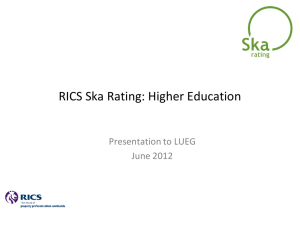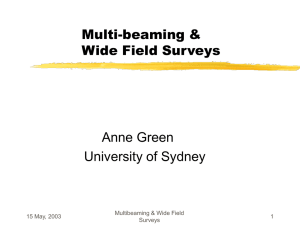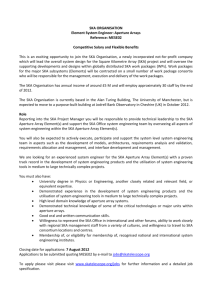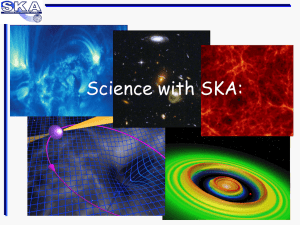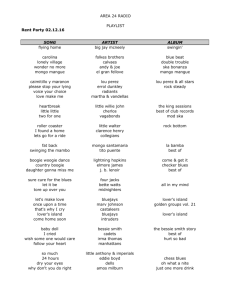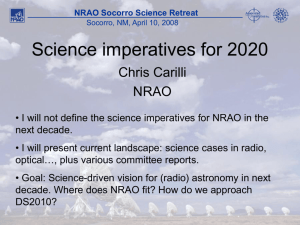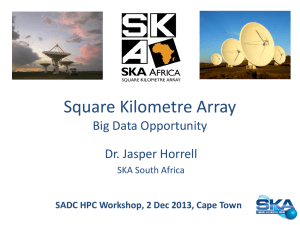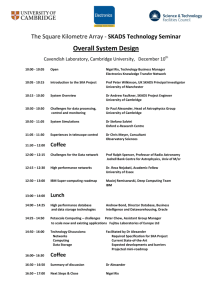Telescopes of the Future-SKA and SKA Demonstrators
advertisement
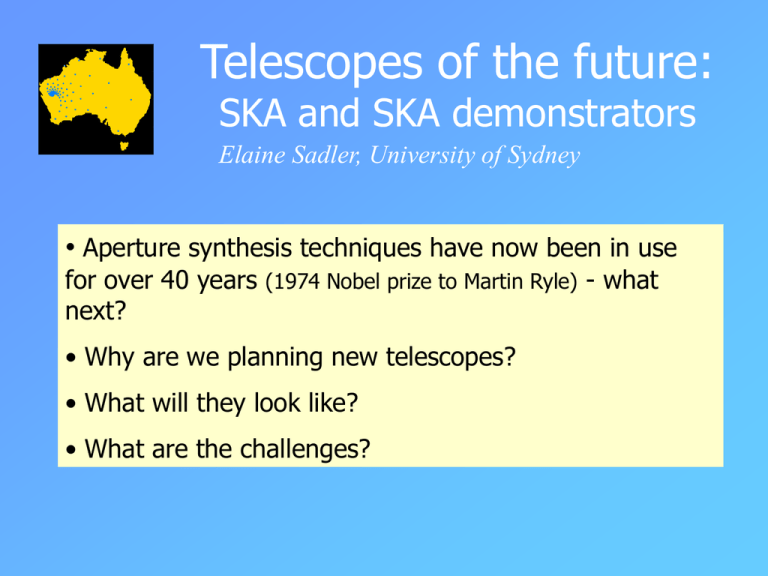
Telescopes of the future: SKA and SKA demonstrators Elaine Sadler, University of Sydney • Aperture synthesis techniques have now been in use for over 40 years (1974 Nobel prize to Martin Ryle) - what next? • Why are we planning new telescopes? • What will they look like? • What are the challenges? Why new radio telescopes? • “Because we can” (new technologies) • “Because we can’t NOT” (or we’ll fall behind and become irrelevant) (Moore’s law, R. Ekers) • To keep up with next-generation optical/IR telescopes • To make new discoveries (new parameter space) • To explore the distant universe (orders of magnitude increase in sensitivity) The long-term advance of radio telescope sensitivity... VLA and Arecibo were such large advances that collecting area unchanged for decades ! Need technology shift to progress ! Probing the distant universe HST VLA SKA In past few years, optical telescopes have begun to probe the `normal’ galaxy population to z~3 The Square Kilometre Array (SKA) The next generation radio telescope Main goals: • Large collecting area for high sensitivity (1 km2), 100x sensitivity of current VLA. • Array elements (stations) distributed over a wide area for high resolution (needed to avoid confusion at very faint flux levels). • For good uv plane coverage (especially for HI observations), stations can’t be too sparse. SKA will be a big-budget, international project SKA collecting area up to 100x VLA Basic design criteria: Sensitivity alone is not enough: hence SKA • Must be sensitive to a wide range of surface brightness many “stations” in the array and wide range of baselines • Must cover factor >10 frequency range as is VLA as does VLA • Must have wide field & ideally multiple beams multi-user; surveying speed and interference mitigation VLA does not Some Proposed Specifications for the SKA (SKA Technical Workshop, 1997) Frequency range 150 MHz – 20 GHz Imaging field of view 1 degree at 1.4 GHz Instantaneous beams 100 Angular resolution 0.1 arcsec at 1.4 GHz Spectral channels 10,000 Image dynamic range 106 at 1.4 GHz Brightness sensitivity 1K at 1.4 GHz Many beams offer great flexibility SKA poster (multi-beams) Many targets/users Interference rejection SKA Configurations Determining (and agreeing on) the optimum SKA configuration is a significant challenge For high resolution, array stations are distributed across a continent (M. Wieringa) SKA antenna concepts US ATA China KARST Australia Luneburg Lenses Canada Large reflector Dutch phased array Australia cylindrical paraboloid Parabolic Reflector Array (SETI Institute, USA) Phased array concept Replace mechanical pointing, beam forming by electronic means Phased array (Netherlands) 1000km (Courtesy NFRA) Luneburg Lens • Spherical lens with variable permittivity • A collimated beam is focussed onto the other side of the sphere • Beam can come from any direction Array station of Luneberg lenses Large [Arecibo-like] Reflectors (China) Aerostat-mounted receiver above Large Adaptive Reflector (Canada) Molonglo SKA cylindrical array prototype (more later…) Darwin AUSTRALIA Brisbane Sydney Perth Adelaide +Molonglo Canberra Melbourne Hobart Challenge: Radio frequency interference (RFI) must be excised to get high sensitivity SKA Science Goals • “The driving ambition for this new facility… is no less than to chart a complete history of time” (Taylor & Braun 1999) • Structure and kinematics of the universe before galaxy formation • Formation and evolution of galaxies • Understanding key astrophysical processes in star formation and planetary formation • Tests of general relativity, etc. SKA science: A concise history of the Universe Dark Ages HI and the Cosmic Web • Spectra of QSOs show many deep Ly-a absorption lines due to low col. density hydrogen (1016 –1017 cm-2 ) • Where from? - diffuse galaxy halos ? - undetected low SB galaxies ? - dwarf galaxies ? - the “cosmic web” ? • Predicted by CDM simulations filaments and sheets with “galaxies” in the over-dense regions • SKA will detect the web via HI in emission! All-sky survey <1017 cm-2 Deep field survey <1016 cm-2 SKA The SKA vision: imaging galaxies in HI with subarcsec resolution NGC 4151 VLA 18 hours current state-of-the-art Imaging HI at <1”resolution needs 100x sensitivity of VLA ~1 square kilometre collecting area study local galaxy dynamics in detail HI at 5 arcsec resolution detect galaxies at high redshift in HI and in synchrotron emission SKA sensitivities for HI ΔV = 30 km s-1; Θ = 1” 8 hour integration Sensitivity: (each polarization) s = 3.8 μJy/beam = 2.39 K Mass Sensitivity: (5 s) ~ 1 x 106 M @ 100 Mpc Sub-dwarf galaxies ~ 4 x 108 M @ z = 1 (resolution ~ 10 kpc) ΔV = 300 km s-1 Θ = 1” 8 hour integration Sensitivity: (each polarization) s = 1.2 μJy/beam = 0.76 K HI Mass Sensitivity: (5 s) ~3 x 106 M @ 100 Mpc ~1.2 x 109 M @ z = 1 (resolution ~ 10 kpc) ~3 x 1010 M @ z = 4 M101-like galaxies at z=4 Large area survey of galaxies in HI Redshifts and HI content of distant galaxies will be obtained for many galaxies HI mass-based census of universe in the simplest atomic species… SKA Studying normal galaxies at high z Unlike O/NIR radio is not affected by dust obscuration • In continuum, HI, OH and H20 masers • SKA sensitivity radio image of any object seen in other wavebands Continuum Neutral Hydrogen OH megamasers H2O masers • Natural resolution advantage cf. ALMA, NGST, HST SKA can study the earliest galaxies in detail Star formation rates in the Universe • Starburst galaxies e.g. M82 M82 optical - Radio VLBI reveals expanding supernovae through dust - Infer star birth rate from death rate rather directly - SKA: Image “M82s” to ~100Mpc : Detect “M82s” at high z - Calibrate integrated radio continuum SFR at high z Madau curve underestimates SFR at z>1.5 M82 VLA+ MERLIN+VLBI SKA’s 10 field-of-view 15 Mpc at z = 2 for surveys and transient events in 106 galaxies ! SKA 20 cm SKA 6cm HST ALMA 2001 MNRF funding for Australian SKA developments August 2001: Major National Research Facilities funding $23.5 million for astronomy (SKA and Gemini) 2001-5 Main SKA-related projects: • Two ‘demonstrator’ array patches (Luneberg lenses or tiles) to be built at or near Narrabri and linked to ATCA • New wide-band correlator for ATCA • Swinburne University - supercomputing and simulations for SKA • University of Sydney - prototype cylindrical paraboloid antenna, digital signal processing, wide-band correlator for Molonglo Stepping stones to SKA: Prototype SKA technologies at Molonglo Joint project between the University of Sydney, Australia Telescope National Facility and CSIRO Telecommunications and Industrial Physics. Funded in 2001 Major National Research Facilities scheme. Goal: To equip the Molonglo telescope with new feeds, low-noise amplifiers, digital filterbank and FX correlator with the joint aims of (i) developing and testing SKA-relevant technologies and (ii) providing a new national research facility for low-frequency radio astronomy Current wide-field imaging with MOST (843 MHz, 12hr synthesis, 2.7o diameter field) Photo: D. Bock Current Survey (1997-2003): The Sydney University Molonglo Sky Survey (SUMSS), imaging the whole southern sky (d<-30o) at 843 MHz to mJy sensitivity with 45” resolution (i.e. similar to NVSS). Next: Use existing telescope as SKA testbed and science facility: - Large collecting area (18,000 m2) - Wide field of view - Continuous uv coverage Cylindrical paraboloid: Continuous uv coverage gives excellent image quality 750 m 1.6 km (Bock et al. 1999) Continuous uv coverage from 90 m to 1.6 km in 12hr synthesis SKA will also have fully-sampled uv data Key features of the Molonglo SKA prototype Collecting area = 1% of SKA (i.e. equivalent to 1 SKA station) Multibeaming Wide instantaneous field of view Digital beamforming Wide-band FX correlator (2048 channels) Frequency and pointing agility Wide-band line feeds and LNAs Cylindrical antenna prototype Adaptive null steering and adaptive noise cancellation Signal Path and Antenna Pattern Cylindrical Parabolic Collectors (Two collinear 778 m x 12 m) 300-1420 MHz Feed and LNA (7,400 feeds, 14,800 LNAs) Delay line beamforming Analog to Digital Converter (1,600 8 bit 250 MHz BW ADCs) Single feed beam Delay line beam Independent fanbeam Imaging beam Digital delay beamforming (80 x10 m x 10 m patches) Digital filterbank (160) (Two polarisations @ 250 MHz/patch) Independent fanbeam FX Correlator Digital Beamformer (3,160 baselines, 2,048 channels) Signal processing & storage (imaging, spectrometer, searching...) (64 fanbeams within imaging beam) [Requires extra funding] Beamformer and Correlator Analog delay line beamforming Accuracy /4 Each polarisation RF 0.3 to 1.4 GHz LO 2.2 to 0.9 GHz IF at 2.5 GHz Quadrature baseband detection Dual 250 MSamples/s 8-bit A/Ds generating a complex 250 MHz signal Digital Beamforming Fine delays accuracy /16 Delay corrects for average analog delay error Arbitrary and time varying grading Modifiable beam shape with meridian distance Resources for adaptive null steering Beamforming and Digital Filterbanks for one of 44 bays Dual Pol. Line feed Delay line beam former,1m section Upconverter, IF, IQ Downconverter and 8-bit Digitiser Upconverter, IF, IQ Downconverter and 8-bit Digitiser LO FAN Beam LO Multi Output Digital Beamformer Connection to Adjacent Beamformer Analogue Optical 250 MHz complex digital filterbanks 120 kHz frequency channels Single FPGA implementation Adaptive noise cancellation on a per channel basis 18 sections per bay Dual Pol. Line feed Delay line beam former,1m section FAN Beam Connection to Adjacent Beamformer Digital Filter bank Digital Filter bank To Correlator Target specifications Parameter Frequency Coverage Bandwidth (BW) Resolution (δ < -30°) 1420 MHz 300 MHz 300–1420 MHz 250 MHz 26" x 26" csc|δ| 123" x 123" csc|δ| Imaging field of view 1.5° x 1.5° csc|δ| 7.7° x 7.7° csc|δ| UV coverage Fully sampled Tsys < 50K < 150K System noise (1σ) 12 hr: 11 μJy/beam 33 μJy/beam 8 min: 100 μJy/beam 300 μJy/beam Polarisation Dual Linear Correlator I and Q (Full Stokes at 125 MHz BW) Frequency resolution 120–1 kHz (FXF mode: 240 Hz) Independent fanbeam 1.3’ x 1.5° 6.2’ x 7.7° Indep. fanbeam offset ±6° ±27° Sky accessible in < 1 s 180 deg2 1000 deg2 Science goals: 1. High-redshift radio galaxies FX correlator: wide-band radio spectrometry Radio spectral index measurements over the range 300 –1400 MHz are an efficient way of selecting high-redshift (z>3) radio galaxies (e.g. de Breuck et al. 2000). Radio galaxy TN0924-2201 at z=5.19 (van Breugel et al. 1999) Science goals: 2. High-redshift HI in galaxies HIPASS (500s) log10 Mlim (HI) (M⊙) 11 (12 h) Molonglo (10x12 h) 10 Typical bright spiral 9 8 0 0.05 0.1 0.15 Redshift z 0.2 0.25 0.3 HI in the nearby Circinus galaxy (Jones et al. 1999) The Molonglo telescope will reach HI mass limits typical of bright spiral galaxies at z=0.2 (lookback time ~3 Gyr), allowing a direct measurement of evolution in the HI mass function. Science goals: 3. Other science projects FX correlator (2048 channels, each 0.2–25 km/s) Redshifted HI absorption (z=0 to 3) OH megamasers Galactic recombination lines (H,C) Pointing agility Rapid response to GRBs Independent fan beam Monitoring programs (pulsars etc.) Optional 64 fanbeams within main beam SETI, pulsar searches (high sensitivity, wide field of view) RFI at Molonglo 200-1500 MHz Measured Power (dBm) (Measured 25 June 2001) UHF TV VHF TV -75 -85 GSM -95 -105 -115 0 500 1000 Frequency (MHz) 1500 Timescales 2002: Design studies 2003: 2 x 10m test patches instrumented with filterbanks and single-baseline correlator 2004: Whole telescope instrumented, commissioning and test observing 2005: Science program begins SKA schedule • 2000 ISSC formed (Europe; US; Australia, Canada, China, India) • 2002 Management plan established • 2005 Agreement on technical implementation and site • 2008 SKA scientific and technical proposal completed • 2010 SKA construction begins ? • 2015 SKA completed ?
